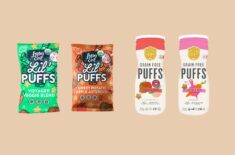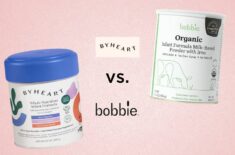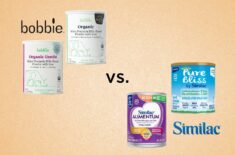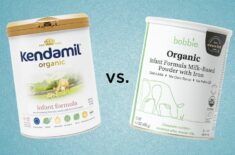Overview
Rice is the main staple food in over 100 countries worldwide. (1)
So, it’s not surprising that it’s among the most common first foods for babies, whether you’re spoon-feeding or following the BLW (baby-led weaning) approach.
However, even with its popularity, you might have also heard about rice’s safety issues.
Does it really have high arsenic content? Is it safe as your baby’s first food? Can babies eat rice in BLW? Should you continue breastfeeding after introducing rice and other solids?
Considering how babies eat so little solid foods, particularly in the first few months, making each mealtime count is important.
You can learn more about the benefits of rice, which variety might be a better choice, and how to make rice safer in baby food recipes in our article below.
Is Rice OK For Baby-Led Weaning?
Dr. Gill Rapley, the pioneer of BLW, lists rice among the foods that can be suitable for your baby’s diet. (2)
She recommends letting your baby self-feed while sharing meals with the whole family. However, it’s important to continue with breast milk or formula feeds as the main source of nutrition for the first year of your baby’s life.
Top Reasons To Serve Rice In BLW
Nutrients
Different rice varieties can have varied nutrient contents, but whole grains are rich in:
- Carbohydrates
- Fiber
- Magnesium
- Phosphorus
- Manganese
- Selenium
- B vitamins like B1 (thiamin) and B6
Other Benefits
- Rice is readily available in many places.
- It has different varieties and flavors.
- Enriched options (more iron content) are also offered.
- It can be easy to cook.
- There are several ways to cook and serve rice.
- It’s versatile and can be mixed with other food groups, including meats, veggies, and fruits.
Is Rice A Choking Hazard?
The CDC (Centers for Disease Control and Prevention) considers grains, such as rice, a potential choking hazard, especially for young children. (3)
Although as individual grains they’re too small to block your baby’s airways, rice can still cause a blockage if they eat too much at the same time.
Also, some grains can accidentally get inside their airways if they’re reclined while eating or quickly tilt their heads backward.
Small grains can be difficult to manage if they’re still learning to swallow.
Note that babies can also choke on other foods, including purées. So, it’s important to learn the differences between gagging and choking to know when they’ll need your help.
Is Rice An Allergen?
No, rice isn’t considered a common allergen. Unlike other grains (including wheat and barley), it doesn’t contain gluten, a potential allergen. (4)
However, even if it’s rare, rice allergies can still happen. (5)(6)
Symptoms of a rice allergy can include: (5)
- Itchy skin
- Hives
- Asthma
- Vomiting and stomachache
- Anaphylaxis (a severe, life-threatening reaction that includes shock and difficulty breathing) in rare cases
A rice allergy usually shows up in infancy, but most people can outgrow it. (5)
However, because it can cause discomfort to your baby, it’s best to ask your pediatrician before introducing rice.
Rice Has High Arsenic Levels
As much as 95% of baby foods and ingredients can contain toxic heavy metals, according to tests conducted by the HBBF (Healthy Babies Bright Futures) organization. (7)
Rice is among the foods with the highest arsenic levels, while sweet potatoes and carrots contain high lead and cadmium levels.
Exposure to heavy metals can lead to heart problems, decreased IQ, respiratory problems, cancer, and neurocognitive (mental function) or behavioral disorders. (8)
Because rice is the leading source of arsenic exposure in young children, the HBBF recommends serving other grains, such as oats, barley, and wheat. (7)
However, if your family is following a gluten-free diet or your little one has gluten allergies, consult a nutritionist, dietitian, or pediatrician before making changes to your baby’s diet.
Is Brown Rice Better Than White Rice For Babies?
Brown rice can be better than white rice because it contains more nutrients. However, while it’s more nutritious, brown rice can also have higher arsenic levels. (7)(9)
Brown Rice (Long Grain) Nutrients
One cup (cooked) can contain the following: (10)
- Calories: 248 kcal
- Carbohydrates: 51.7 g
- Proteins: 5.54 g
- Iron: 1.13 mg
- Phosphorus: 208 mg
- Magnesium: 78.8 mg
- Calcium: 6.06 mg
- Vitamin B6: 0.248 mg
White Rice (Long Grain) Nutrients
One cup (cooked) can contain the following: (11)
- Calories: 205 kcal
- Carbohydrates: 44.6 g
- Proteins: 4.25 g
- Iron: 1.9 mg
- Phosphorus: 67.9 mg
- Magnesium: 19 mg
- Calcium: 15.8 mg
- Vitamin B6: 0.147 mg
Still, many experts agree that despite the potential arsenic risks, brown rice might still be better than white rice due to its nutritional value. (1)
You can opt for brown basmati rice from California, India, and Pakistan because they might have the lowest arsenic levels. (7)(9)
Most varieties marked as “US Rice,” usually from Arkansas, Louisiana, and Texas, can have the highest arsenic content. (7)(9)
How To Reduce Arsenic In Rice
Studies show that rinsing rice several times before cooking can reduce its arsenic content by 10%. (12)(13)
Boiling it in lots of water can further reduce inorganic arsenic levels by 45-60% (six cups of water per one cup of rice) or as much as 85% (12:1 water to rice ratio). (12)(13)(14)
Here’s how to cook rice to reduce its arsenic content:
- Rinse at least twice.
- Add 12 cups of water per cup of rice. Boil.
- Once the water is boiling, you can drain the rice on a colander or decant the water from the pot.
- Continue cooking on low fire. You can add a cup of water if the rice still looks hard.
You can use this arsenic-reduced rice in other baby-led weaning recipes or serve it on its own.
How Much Rice Is Safe For Your Baby To Eat?
These are the recommended limits by Consumer Reports, based on their risk analysis: (9)
- White basmati or sushi rice, ¼ cup uncooked – up to three times a week
- All other rice varieties, ¼ cup uncooked – once a week
- Rice pasta, 2 oz uncooked – once a week
- Rice crackers, 16-18 crackers per serving – around twice a week
- Infant rice cereal, ¼ cup uncooked – around six times a week
How Do You Serve Rice For Baby-Led Weaning?
Although it can sometimes be challenging for younger babies to self-feed with rice, you can offer your little foodie rice-based finger foods like veggie rice balls.
Older babies can try using a silicone spoon to scoop their rice meals.
Other examples to serve rice can include:
- Congee or rice porridge with bone broth, a small amount of olive oil, and slices of meat and veggies
- Steamed rice cakes
You can also cook rice with quinoa, low-mercury fish (like salmon), and options from other food groups.
However, hold the added sugar or salt in preparing your baby’s meals.
Excess sugars can cause obesity while added salt isn’t necessary because babies get enough from breast milk or formula. (15)(16)
How Do I Introduce Rice To My Six-Month-Old?
You can gently mash cooked rice with a fork and create a slightly sticky ball they can hold and munch on. They can pick it up from their high chair tray or a bowl.
Like other new foods you introduce for the first time, it’s good to wait a few days before adding a different food. It can help you trace which foods might cause an allergic reaction to your baby.
Don’t give uncooked rice to babies. Instead, cook it until soft.
Can I Give My Seven-Month-Old Baby Rice?
Yes, your baby can self-feed with finger foods like rice balls or begin learning how to use a spoon to eat congee and other soft rice dishes at seven months of age.
REFERENCES
(1) https://www.hsph.harvard.edu/nutritionsource/food-features/rice/
(2) http://www.rapleyweaning.com/assets/blwleaflet2.pdf
(3) https://www.cdc.gov/nutrition/infantandtoddlernutrition/foods-and-drinks/choking-hazards.html
(4) https://www.beyondceliac.org/gluten-free-diet/is-it-gluten-free/rice/
(5) https://www.nyallergy.com/rice-allergy/
(6) https://www.ncbi.nlm.nih.gov/pmc/articles/PMC3250595/
(7) https://www.healthybabyfood.org/sites/healthybabyfoods.org/files/2019-10/BabyFoodReport_FULLREPORT_ENGLISH_R5b.pdf
(8) https://pubmed.ncbi.nlm.nih.gov/30941546/
(9) https://www.consumerreports.org/cro/magazine/2015/01/how-much-arsenic-is-in-your-rice/index.htm
(10) https://fdc.nal.usda.gov/fdc-app.html#/food-details/169704/nutrients
(11) https://fdc.nal.usda.gov/fdc-app.html#/food-details/168878/nutrients
(12) https://pubmed.ncbi.nlm.nih.gov/19137137/
(13) https://www.fda.gov/files/food/published/Arsenic-in-Rice-and-Rice-Products-Risk-Assessment-Report-PDF.pdf
(14) https://pubmed.ncbi.nlm.nih.gov/26200355/
(15) https://www.ncbi.nlm.nih.gov/pmc/articles/PMC6959843/
(16) https://www.nhs.uk/live-well/eat-well/salt-nutrition/












